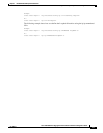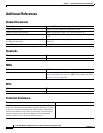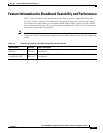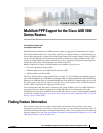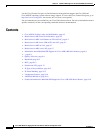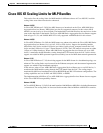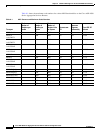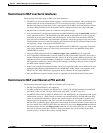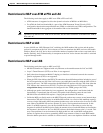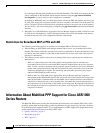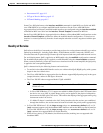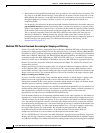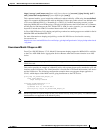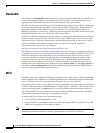
8-5
Cisco ASR 1000 Series Aggregation Services Routers Software Configuration Guide
OL-16506-17
Chapter 8 Multilink PPP Support for the Cisco ASR 1000 Series Routers
Cisco IOS XE Scaling Limits for MLP Bundles
Restrictions for MLP over Serial Interfaces
The following restrictions apply to MLP over Serial Interfaces:
• The MLP over Serial Interfaces feature supports a maximum of ten member links per bundle. The
member links can be any combination of T1/E1 or fractional T1s/E1s (for example, NxDS0).
Member-link interface speed above T1/E1 is not supported in the MLP over Serial Interfaces feature.
For better MLP performance, all the member links in a bundle must be of the same bandwidth.
• Member links in a bundle cannot be of different encapsulation types.
• You cannot manually configure the bandwidth of an MLP bundle by using the bandwidth command
on the multilink interface. The bandwidth of an MLP bundle is managed based on the aggregate
bandwidth of all the active member links on the bundle. As the links are dynamically added or
removed from an MLP bundle, the bandwidth is updated to reflect the aggregate of the active links.
The bandwidth can be rate limited by applying an hierarchical QoS policy on the multilink interface
and applying a shaper to the parent class-default class.
• MLP over Frame Relay is not supported; only MLP over Serial PPP link is supported. Customers
who require multilink support in a frame relay environment can use the Multilink Frame Relay
(MLFR-FRF.16) feature.
• The legacy IOS compression feature compress [mppc | stac | predictor] is not supported.
• LFI is supported on MLP bundles with any number of links in the bundle. However, when using a
bundle with more than one member link, the order of the priority packets (PPP encapsulated) is not
guaranteed. Priority-packet distribution is handled in a manner similar to IP per-packet load sharing.
MLP guarantees nonpriority packet ordering that manages reordering at the peer device, based on
the MLP packet sequence number.
• Order issues with the LFI multiple-member link in case of priority traffic can be addressed in some
platforms using Multiclass Multilink Protocol (MCMP-RFC 2686), which is an extension of the
MLP. The Cisco ASR 1000 Series Aggregation Services Routers do not support MCMP.
• Only the MLP long-sequence number format is supported for the packet header format option.
Restrictions for MLP over Ethernet at PTA and LAC
The following restrictions apply to MLP over Ethernet at PTA and LAC:
• MLPoE using EtherChannel is not supported.
• For MLP virtual access bundles, the default Layer 3 (that is IP and IPv6) maximum transmission
unit (MTU) value is 1500. For more information about MTU, see MTU, page 8-12.
• For MLPoE PTA variations (MLPoE, MLPoVLAN, and MLPoQinQ), the default bandwidth of the
member-link session is 1 Gbps instead of the data rate communicated by the DSLAM to the PTA
router. If a bandwidth statement is added to the virtual template, the bandwidth is applied to the
bundle instead of the member link. This is not the desired behavior. (To define the data rate of an
MLPoE PTA-type bundle, apply a QoS policy on the bundle session that includes a parent shaper on
the class-default class with an explicit data rate defined. Do not use the shape percent command in
this parent shaper because the shape percent command uses the default data rate of 1 Gbps as the
base rate for percent calculation. However, the percent-based rates can be defined in the child
(nested) policy, if an hierarchical policy is being defined.



